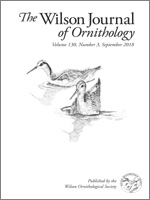Dendrocincla woodcreepers (Furnariidae: Dendrocolaptinae) are known for their foraging associations with army ants and mammals and for their emancipated males, which provide no parental care. Little is known of the natural history of the Plain-winged Woodcreeper (Dendrocincla turdina), an Atlantic Forest endemic. In Paraguay (2000–2002) and Argentina (2000–2016), we nearly always found Plain-winged Woodcreepers foraging in association with black capuchin monkeys (Sapajus nigritus), unless they were attending a nest, when they foraged alone, often by sally-gleaning. In our main study area, Parque Provincial Cruce Caballero, encounter rates of both monkeys and Plain-winged Woodcreepers increased dramatically after 2012. We found 2 nests, 1 with 2 eggs and the other with 2 nestlings, both in deep, nonexcavated tree cavities in shady forest understory. One secretive adult attended each nest; there was no evidence of a pair bond with another adult. During incubation, nest attentiveness was 62%, on-bouts were mean 35 (SE 5) min (range 3–83; n = 21) and off-bouts averaged 16 (SE 1) min (range 8–28; n = 24). The adult brought lichens and a few other nesting materials throughout the incubation period and sometimes used them to cover the eggs when it left the nest. Once the eggs hatched, nest attentiveness declined rapidly, although the adult roosted with the nestlings until they were 14 days old. Nestling diet included arthropods (especially Orthoptera, Lepidoptera, Hemiptera, and Coleoptera) and vertebrates (bat and frog) but differed between the 2 nests, suggesting opportunism. The adult brought food much more frequently around sunrise (7.93 [SE 0.69] visits/h) and sunset (8.03 [1.19] visits/h) than during the rest of the day (3.26 [0.22] visits/h). Nestling development was slower than for coexisting Dendrocolaptinae with biparental care, and the nestlings fledged when 26–27 days old. Uniparental care is unusual in forest insectivores but has arisen at least twice in Dendrocolaptinae and seems to be associated with hiding of eggs, secretive behavior, and slow nestling growth.
How to translate text using browser tools
1 September 2018
Nesting and natural history of the Plain-winged Woodcreeper (Dendrocincla turdina): foraging associations and uniparental care
Alejandro Bodrati,
Kristina L. Cockle,
Facundo G. Di Sallo
ACCESS THE FULL ARTICLE
Dendrocincla turdina
foraging association
MONKEY
nest concealment
nestling development
nestling diet
uniparental care





